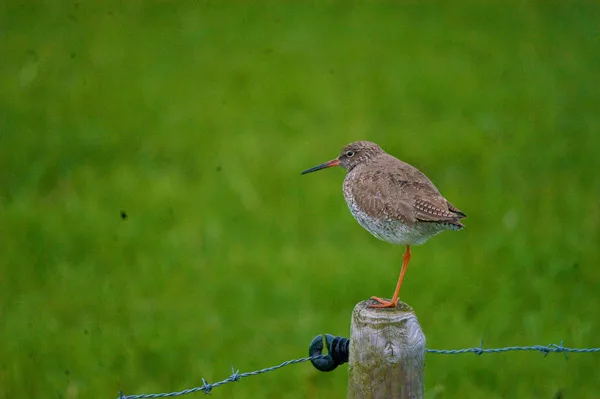
Copyright Sjaak Gruntjes
[order] CHARADRIIFORMES | [family] Scolopacidae | [latin] Tringa totanus | [UK] Redshank | [FR] Chevalier gambette | [DE] Rotschenkel | [ES] Archibebe Comun | [NL] Tureluur
Subspecies
| Genus | Species | subspecies | Breeding Range | Breeding Range 2 | Non Breeding Range |
Physical charateristics
Ashy brown upperparts, head and breast, streaked and spotted with black and dark brown. White secondaries conspicuous in flight.
Differs from non-breeding T. erythropus by shorter, orange-red legs, shorter bill, indistinct supercilium and redder bill.
Female often has paler upperparts than male, at least in race totanus.
Non-breeding adult has gteyer upperparts, without streaks or spots, but some narrow white fringes, underparts paler, breast finely streaked.
Races generally vary only in small details of plumage and size, robusta and ussuriensis more cinnamon.
Differs from non-breeding T. erythropus by shorter, orange-red legs, shorter bill, indistinct supercilium and redder bill.
Female often has paler upperparts than male, at least in race totanus.
Non-breeding adult has gteyer upperparts, without streaks or spots, but some narrow white fringes, underparts paler, breast finely streaked.
Races generally vary only in small details of plumage and size, robusta and ussuriensis more cinnamon.
Listen to the sound of Redshank
[audio:http://www.aviflevoland.nl/sounddb/R/Redshank.mp3]
Copyright remark: Most sounds derived from xeno-canto
| wingspan min.: | 45 | cm | wingspan max.: | 52 | cm |
| size min.: | 27 | cm | size max.: | 29 | cm |
| incubation min.: | 22 | days | incubation max.: | 25 | days |
| fledging min.: | 25 | days | fledging max.: | 25 | days |
| broods: | 1 | eggs min.: | 3 | ||
| eggs max.: | 5 |
Range
Eurasia : West, Central
Habitat
Wide diversity of inland wetlands and coastal, including inland wet grasslands, grassy marshes and swampy heathlandsand coastal salt-marshes.
After breeding, chiefly in coastal habitats including rocky, muddy and sandy shorelines, salt-marshes and open mudflats, salt-lakes, freshwater lagoons. Sometimes at inland waters or flooded grasslands.
After breeding, chiefly in coastal habitats including rocky, muddy and sandy shorelines, salt-marshes and open mudflats, salt-lakes, freshwater lagoons. Sometimes at inland waters or flooded grasslands.
Reproduction
Egg laying from April to June. Monogamous pair bond. Moderate degree of natal pilopatry (consectutive generations breed in the area) in experienced and successful breeders, of site faithfulness and mate fidelity. Breeds solitary or in loose colonies. Nest typically at base of tall clump of grass, with leaves covering overhead. 4 eggs are laid, incubation 24 days, by both sexes. Chick has creamy or greyish buff upperparts with black-brown lines, buff suffused breast and whitish underparts. Both parents initially tend young, but later on often only male. Age of first breeding 1-2 years.
Feeding habits
Insects, spiders and annelids. Non-breeders also consume mollusccs and crustaceans, particularly amphipod, on occasion, feeds on small fish or tadpoles.
Like diet, feeding method varies seasonally. Uses typical brisk walk while picking, occasionally probes, jabs or sweeps bill ghrough water. Often wades, and occasionally swims. When feeding on fish, may forage socially in dense flock, often mixed with other tringines.
Feeds diurnally and nocturnally. Mostly in small flocks, occasionally many 100’s, sometimes singly.
Like diet, feeding method varies seasonally. Uses typical brisk walk while picking, occasionally probes, jabs or sweeps bill ghrough water. Often wades, and occasionally swims. When feeding on fish, may forage socially in dense flock, often mixed with other tringines.
Feeds diurnally and nocturnally. Mostly in small flocks, occasionally many 100’s, sometimes singly.
Conservation
This species has an extremely large range, and hence does not approach the thresholds for Vulnerable under the range size criterion (Extent of Occurrence <20,000 km2 combined with a declining or fluctuating range size, habitat extent/quality, or population size and a small number of locations or severe fragmentation). The population trend is not known, but the population is not believed to be decreasing sufficiently rapidly to approach the thresholds under the population trend criterion (>30% decline over ten years or three generations). The population size is very large, and hence does not approach the thresholds for Vulnerable under the population size criterion (<10,000 mature individuals with a continuing decline estimated to be >10% in ten years or three generations, or with a specified population structure). For these reasons the species is evaluated as Least Concern.

Migration
Mainly migratory, though some resident in maritime countries of western Europe. Though 3 subspecies occur in west Palearctic, broad intergradation zones between them make it impractical to attempt separation of populations on racial basis. In general, smallest birds (from northern Fenno-Scandia) winter furthest south (West Africa), while largest (Icelandic) winter on average furthest north (Iceland to North Sea); intermediate-sized birds of west-central Europe winter in intermediate latitudes centred on France, Iberia, and western Mediterranean. European migration mainly SW-SSW in autumn (reversed in spring); important concentrations along coasts, but also many cross overland (overflying large areas), and passage probably broad-front.
Distribution map

